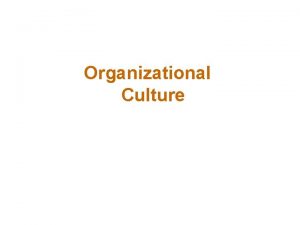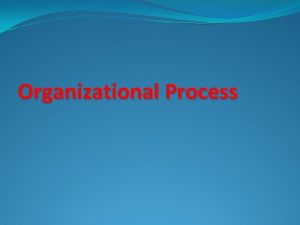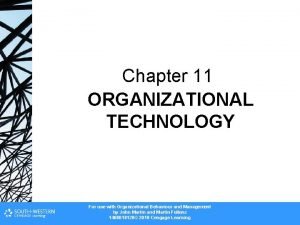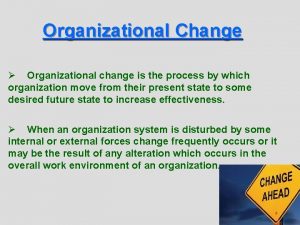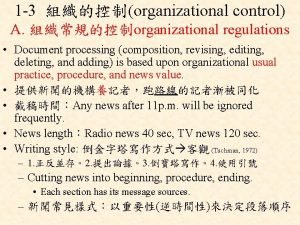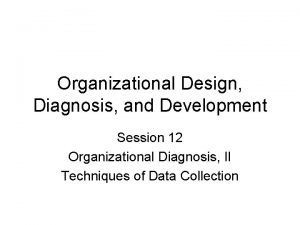Use of an Organizational Process for CorporateWide Process


















- Slides: 18

Use of an Organizational Process for Corporate-Wide Process Improvement via CMMI® NDIA/SEI CMMI® Technology Conference November 2003 John Evers David Zeek Manager, Process & Tools Manager, RECP CMMI® Project IIS Mid-Atlantic Garland, TX Falls Church, VA Customer Success Is Our Mission

Raytheon Engineering Common Program Analog, RF, Microwave Digital Electronics Electro-Optical Mechanical Software Business Systems Business Engineering & Technology Councils One Company integration through a common program IPDS RECP – Recipient of AFEI’s 2003 Industry award for November 2003, Slide 2 Excellence in Enterprise Integration

Raytheon's Common Process Culture Integrated Product Development System (IPDS) provides an integrated set of best practices for the entire product development life cycle using a program tailoring process. Raytheon Six Sigma guides us to use CMMI® and IPDS as tools to deliver value to customers and integrate industry best practices. Capability Maturity Model Integration (CMMI®) provides the requirements for creating, measuring, managing, and improving specific processes. Raytheon Engineering Common Program is the enterprise enabler for these initiatives November 2003, Slide 3

Executing Enterprise CMMI® Strategy • Incorporated changes to bring IPDS into Level 3 compliance with CMMI® • Update IPDS to Level 5 compliance using incremental releases • Upgrading support infrastructure in conjunction with IPDS upgrades (web sites, Process Asset Libraries, tools…. . ) • Supporting Raytheon businesses in their CMMI® deployment, training, appraisals, and improvements • Continuing involvement in external activities with CMMI® • Teaming with the Software Productivity Consortium (training, assessment, consulting…) Building on successful (IPDS) process deployment and usage expedites CMMI® deployment November 2003, Slide 4

The Vision Leveraging R 6 s improvements corporate-wide Past Reality Driven by R 6 s To-Be State • Focus: Prevent Problems • Focus: Fix Problems – High Variability – Lack of discipline – Can’t move work around – Diverse Processes • “Multiple” Raytheons – Predictable Performance and Reduced Variability – Disciplined Execution – Common Processes – Ability to collaborate and move work to available resources • One Raytheon Captured in IPDS - Validated by CMMI® November 2003, Slide 5

History of IPDS Legacy Company Consolidation RES - EDP/TTP Based on Industry and Commercial Standards EIA 632 RESYS - IPDP Processes for Engineering a System RTIS - IPDP IEEE 1220 Standard for Application and Management of the Systems Engineering Process knowledge SYNTHESIS ISO 12207 Information Technology: Software Life Cycle Processes” SY NT H Capture and ES IS embed expert Use existing strengths to close gaps SIS E H NT Y S RHAC - IPA/PDP Four Separate Product Development Systems (Processes, Tools, Training, Information Management) Establishing Legacy “Best Practices” • Discipline Processes • Product Processes • Unifying Process • Tools • Training • Information Management for the RSC common Product Development System Raytheon - IPDS Goals Reduced Cycle Time, Defects/Unit and Cost Integrated Product Development System (IPDS) • Business Units drive IPDS development / improvement through RECP and CRs • > 2000 CRs submitted since April 1998; led to 10 improved releases of IPDS November 2003, Slide 6

Integrated Product Development System Defines the way we plan, capture, and execute programs Provides “One Company” language and tools to enable program capture and successful execution Provides an environment for continuous process improvement Provides tools and processes that enable Integrated Product Teams to perform their tasks Building a Process Culture Requires Discipline November 2003, Slide 7

Web Shot of IPDS Return to Home Page (shown) Access to Main and Sub-Process Info Access to IPDS Processes and Policies Access to Supporting Process Info Access to Gates Info Access to Deployment Info Access to Site Search Engine Access to Contact Info for IPDS Access to IPDS Help Desk Access to Enablers Access to IPDS Glossary/ Acronym List Access to Version Description Access to IPDS Change Process Access to Global View of IPDS Access to Process Asset Libraries (PALs) Access to Related Websites November 2003, Slide 8

Deployment Methods Are Integral to IPDS • PROCESSES • TASK DESCRIPTORS • GUIDELINES & REFERENCES • METHODS / PROCEDURES • CHECKLISTS • TEMPLATES PROCESS DOCUMENTATION AND ENABLERS • TOOLS • PRODUCIBILITY / DFMA • MEASURES • TRAINING DEPLOYMENT TO PROGRAMS Integrated Planning (IMP/IMS/EVM) ORGANIZATIONAL DESIGN Multidiscipline, Customer Focus Aligned • Product Structure • WBS • Program Organization • INTEGRATED PRODUCT TEAMS • TEAM BUILDING November 2003, Slide 9

Integrated Product Development Process Is the Overarching Process Horizontal navigation follows nominal, progressive timeline across the life cycle 1 Business Strategy Execution Business/ Strategic Planning Program Capture/ Proposal 2 - Project Planning, Management and Control 3 Requirements and Architecture Development 4 Product Design and Development Planning 5 System Integration, Test, Verification and Validation (ITV&V) 6 - Production and Deployment 7 - Operations and Support November 2003, Slide 10

IPDP Documentation Hierarchy TOP Vertical hierarchy reveals successive levels of detail 3 REQUIREMENTS AND ARCHITECTURE DEVELOPMENT 3 -01 System Requirements Definition 3 -02 System Preliminary Design 3 -03 Product Requirements Definition 3 -04 Product Preliminary Design 3 -05 Component Requirements Definition LEVEL 2 INT 3 -04 PRODUCT PRELIMINARY DESIGN LEVEL 1 FLOWCHART 3 -04. 02 Analyze Functional Behaviors 3 -04. 01 Define Product Functions 3 -04. 03 Identify Physical Product Alternatives 3 -04. 05 Establish Product Architectures 3 -04. 06 SRR/SDR 3 -04. 07 Establish Product Baselines 3 -04. 04 Define Standardization Opportunities DET 3 -04. 05. 02 Establish Functional Architecture 3 -04. 05 ESTABLISH PRODUCT ARCHITECTURES 3 -04. 05. 04 Define Verification Procedures 3 -04. 05. 06 Conduct Verification Evaluation 3 -04. 05. 08 Establish Physical Architecture 3 -04. 05. 09 Perform Product Rollup 3 -04. 05. 10 Assess Safety & Environmental Hazards 3 -04. 05. 12 Assess Product Testability & FMEA TASK DESCRIPTORS LEVEL 3 November 2003, Slide 11

IPDP Includes Program Check Points Called Gates Asking the right questions. . . at the right time. . . by the right people 1 2 3 4 Interest / No Interest Pursue / No Pursue Bid / No Bid / Proposal Review 1 Business Strategy Execution Business/ Strategic Planning Program Startup Review Decision Gates Internal System Functional Review Internal Preliminary Design Review Internal Critical Design Review Internal Test / Ship Readiness Review Internal Production Readiness Review Program Capture/ Proposal 5 1 11 2 - Project Planning, Management and Control 6 3 Requirements & Architecture Development 7 8 4 Product Design and Development Planning Transition & Shutdown 5 9 10 System Integration, Test, Verification and Validation 6 - Production and Deployment 7 - Operations and Support November 2003, Slide 12

What Is the Effect of CMMI®? • CMMI® addresses policies & directives, organizational processes, and detailed procedures in addition to project processes • CMMI® imposes additional requirements on organizations • E. g. , IPDS is based around and encourages use of IPTs but does not require them. CMMI® IPPD makes them a requirement. Policies / Directives Program/ Project Processes Business/ Organization Processes Detailed Procedures • CMMI® provides a yardstick for process improvement Programs are Using CMMI®-Aligned Processes (IPDS) – Organizational Integration and Documentation are Needed November 2003, Slide 13

Process Architecture Business Needs Business P&P CMMI® Requirements Organizational Process Set Local Materials augment and provide detailed “how to” for businesses at Raytheon sites Policies Procedures Methods Enablers Training Tailoring Guide Program-specific Procedures and Work Instructions November 2003, Slide 14

Process Asset Library Architecture (8) Select Archive to list all versions of asset (7) Select icon to open asset (1) PAL Access; Search by Criteria Function (2) Select desired criteria (3) List of criteria matches in same Window (scroll to view matches) (6) Select parent or child asset name to regenerate same window for new pick (5) Select asset name to view asset attributes and all parent/child relationships (4) Select icon to open asset November 2003, Slide 15

Lessons Learned • Process deployment model and method are as important as • • process documentation Organizational behavioral changes are primary factors critical to success Site engagement is critical to success against CMMI® Early program engagement is critical to realize benefits from integrated planning using common processes Closed, tightly coupled processes (low coherence, high dependence) can hinder improvements • Consistent top-level flow can synchronize processes • Think open process architecture • Important to identify and address common subprocesses, such as risk management and requirements management, as well as other supporting (call-able) subprocesses, such as decision analysis November 2003, Slide 16

IPDS, CMMI®, and R 6 s Support Each Other • ID and prioritize gaps • Improve processes Process requirements Process Definition & Improvement Appraise capability maturity Standard processes & methods • R 6 s Improves Program Processes • R 6 s Closes Gaps Identified by CMMI® Appraisals Process Deployment and Application • • Tailor processes Execute Design for Six Sigma Improve processes November 2003, Slide 17

Questions John Evers Raytheon 7700 Arlington Blvd. Falls Church, VA 22042 john-evers@raytheon. com 703 -560 -5000 x 4359 David Zeek Raytheon CBN LC 3000 P. O. Box 660023 Dallas, TX 75266 -0023 David_A_Zeek@raytheon. com 972 -205 -4326 Customer Success Is Our Mission
 Iso 22301 utbildning
Iso 22301 utbildning Novell typiska drag
Novell typiska drag Tack för att ni lyssnade bild
Tack för att ni lyssnade bild Ekologiskt fotavtryck
Ekologiskt fotavtryck Shingelfrisyren
Shingelfrisyren En lathund för arbete med kontinuitetshantering
En lathund för arbete med kontinuitetshantering Kassaregister ideell förening
Kassaregister ideell förening Personlig tidbok
Personlig tidbok A gastrica
A gastrica Densitet vatten
Densitet vatten Datorkunskap för nybörjare
Datorkunskap för nybörjare Stig kerman
Stig kerman Att skriva debattartikel
Att skriva debattartikel För och nackdelar med firo
För och nackdelar med firo Nyckelkompetenser för livslångt lärande
Nyckelkompetenser för livslångt lärande Påbyggnader för flakfordon
Påbyggnader för flakfordon Tryck formel
Tryck formel Offentlig förvaltning
Offentlig förvaltning Jag har nigit för nymånens skära
Jag har nigit för nymånens skära




















